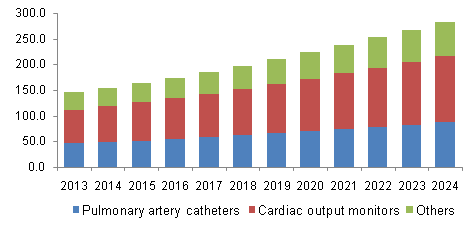The global atrial fibrillation market is expected to reach USD 16.17 billion by 2020. Rising occurrence of strokes, brain damage and atrial fibrillation owing to blood clots along with an increasing geriatric population is expected to drive industry growth. Technological advancements in the field of microwave catheter ablation and radiofrequency along with rising occurrence of diseases caused by lifestyle habits such as drinking and smoking are further expected to fuel growth. Moreover, increasing demand for smaller cardiac incisions, minimally invasive procedures and small recovery time post-surgery are projected to bolster growth. Also, global aging population combined with the changes in lifestyle increasing the risks of obesity and high blood pressure is likely to drive demand.
Pharmacological products accounted for over 50% market share in 2013. Low prices of these products along with increasing use of anti-coagulants as an add-on therapy to non-pharmacological procedures are expected to drive demand.
View
summary of this report @ http://www.grandviewresearch.com/industry-analysis/atrial-fibrillation-treatment-industry
Further Key findings from the study
suggest:
·
North America accounted for over 40% of global
revenue in 2013. High penetration of non-pharmacological procedure and
sophisticated reimbursement frameworks has resulted in its substantial demand
over the past few years. High patient awareness and healthcare expenditure
levels also contributed significantly towards region growth.
·
Asia-Pacific is expected to witness substantial
growth during the forecast period, growing at a CAGR of over 13% from 2015 to
2022. Rising demand for non-pharmacological treatments due to improvement in
healthcare infrastructure, high disposable incomes, and growing patient
awareness are a few factors accounting for its rapid growth.
·
Radiofrequency catheter ablation procedure
segment is expected to be the fastest growing segment with a CAGR of over 12%
over the forecast period. Technological advancements related to maneuverability
which helps in making tight bends inside the heart, the optimal size of the
lesion produced and lower time required to recover from of catheter ablation is
expected to drive demand over the next seven years.
·
Maze surgery occupied the second largest share
of non-pharmacological treatment market. It removes the need for life-long
anti-coagulants based treatment while reducing the occurrence of strokes.
Anti-coagulants held the dominant market share in pharmacological treatment
market as it reduced the incidence of blood clots and strokes which in turn is
likely to propel demand over the projected period.
·
Key industry players include Boston Scientific
Corporation, St. Jude Medical Inc., Johnson & Johnson Ltd., Sanofi-Aventis,
CardioFocus Inc., Boehringer Ingelheim GmbH, Bristol-Myers Squibb Corporation,
Biosense Webster Inc., AtriCure Inc. and Endoscopic Technologies Inc. St. Jude
Medical Inc. developed an Endosense’sTactiCath. The technology provides live
feedback related to pressure applied during microwave catheter ablations and
radiofrequency.
Browse All Reports of
this category @ http://www.grandviewresearch.com/industry/healthcare
Grand View Research has segmented the global atrial fibrillation market on the basis of fields of procedures and region:
Atrial Fibrillation Procedures Outlook
• Pharmacological Products
• Anti-arrhythmic Drugs
• Anti-coagulant Drugs
• Non-Pharmacological Treatment
• Catheter Ablation Procedures
• Radiofrequency
• HIFU
• Cryoablation
• Microwave
• Laser
• Maze Surgery
• Electric Cardioversion
Atrial Fibrillation Regional Outlook
• North America
• Europe
• Asia Pacific
• RoW
